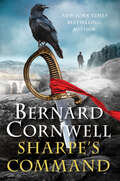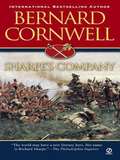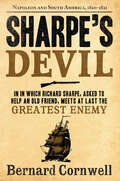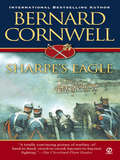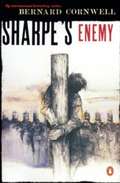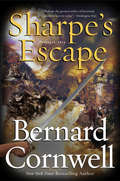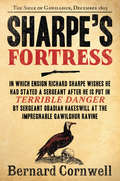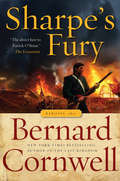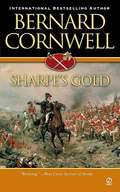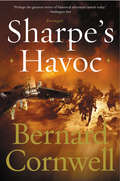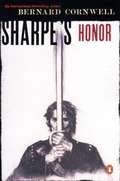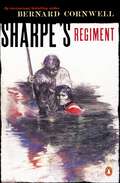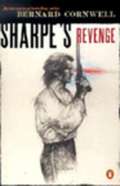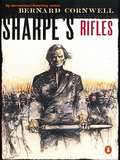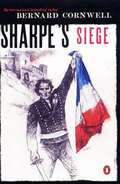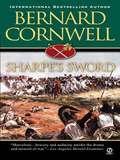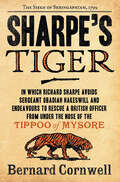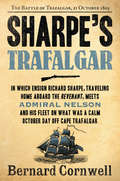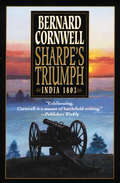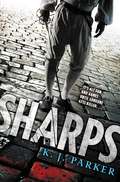- Table View
- List View
Sharpe's Command: Richard Sharpe and the Bridge at Almaraz, May 1812 (Sharpe #14)
by Bernard CornwellNew York Times bestselling author Bernard Cornwell returns to the early years of the nineteenth century, capturing the bravery, battles, and bloodshed of Britain’s peninsular wars with this epic tale featuring his iconic hero Richard Sharpe.Outsider.Hero.Rogue.If any man can do the impossible it’s Richard Sharpe.And the impossible is exactly what the formidable Captain Sharpe is asked to do when he’s sent on an undercover mission to a small village in the Spanish countryside, far behind enemy lines.For the quiet, remote village, sitting high above the Almaraz bridge, is about to become the center of a battle for the future of Europe. Two French armies march towards the bridge, one from the North and one from the South. If they meet, the British are lost.Only Sharpe's small group of men—with their cunning and courage to rely on—stand in their way. But they're rapidly outnumbered, enemies are hiding in plain sight, and as the French edge ever closer to the frontline, time is running out. . . .
Sharpe's Company
by Bernard CornwellTo stem the Napoleonic tide, Sharpe must capture a fortress--where his wife and infant daughter are trapped--while protecting himself from a fellow officer determined to destroy him.
Sharpe's Company: Richard Sharpe and the Siege of Badajoz, January to April 1812 (Richard Sharpe #13)
by Bernard CornwellTHE BRITISH MUST MOUNT A BLOODY ATTACK THAT NO MAN COULD SURVIVE--NO MAN EXCEPT CAPTAIN RICHARD SHARPE. Looming on the border of Portugal and Spain is the fortress of Badajoz. To lead an assault on its thick, sheer walls and battlements is suicide, yet Richard Sharpe must lead one. Inside the walls are his wife and daughter, and only he can save them. Outside is the misshapen, vengeance-crazed Sergeant Obadiah Hakeswill, a man determined to kill Sharpe. Sharpe knows that in the heat of battle only the cold steel of his battered sword and the ruthless bloodlust of a soldier at war will protect him from the danger of both sides.
Sharpe's Devil: Napoleon and South America, 1820-1821 (Sharpe #23)
by Bernard CornwellFrom New York Times bestselling author Bernard Cornwell, another exciting adventure in the world-renowned Sharpe series, chronicling the rise of Richard Sharpe, a Private in His Majesty’s Army at the siege of Seringapatam. Five years after the Battle of Waterloo, Sharpe’s peaceful retirement in Normandy is shattered. An old friend, Don Blas Vivar, is missing in Chile, reported dead at rebel hands – a report his wife refuses to believe. She appeals to Sharpe to find out the truth.Sharpe, along with Patrick Harper, find themselves bound for Chile via St. Helena, where they have a fateful meeting with the fallen Emperor Napoleon. Convinced that they are on their way to collect a corpse, neither man can imagine that dangers that await them in Chile…
Sharpe's Eagle: Richard Sharpe And The Talavera Campaign, July 1809 (Richard Sharpe Adventure Ser. #No. 8)
by Bernard CornwellAfter the cowardly incompetence of two officers besmirches their name, Captain Richard Sharpe must redeem the regiment by capturing the most valued prize in the French Army--a golden Imperial Eagle, the standard touched by the hand of Napoleon himself.
Sharpe's Enemy
by Bernard CornwellA band of renegades led by Sharpe's vicious enemy, Obadiah Hakeswill, holds a group of British and French women hostage on a strategic mountain pass. Outnumbered and attacked from two sides, Sharpe must hold his ground or die in the attempt.
Sharpe's Enemy: Richard Sharpe and the Defence of Portugal, Christmas 1812 (Richard Sharpe's Adventure Series #16)
by Bernard CornwellRenegades occupy a village and kidnap some women. Sharpe must face his old enemy Obadiah Hakeswill in order to rescue the hostages.
Sharpe's Escape: The Bussaco Campaign, 1810 (Sharpe #10)
by Bernard CornwellFrom New York Times bestselling author Bernard Cornwell, the tenth installment in the world-renowned Sharpe series, chronicling the rise of Richard Sharpe, a Private in His Majesty’s Army at the siege of Seringapatam. Sharpe’s job as Captain of the Light Company is under threat and he has made a new enemy, a Portuguese criminal known as Ferragus. Discarded by his regiment, Sharpe wages a private war against Ferragus – a war fought through the burning, pillaged streets of Coimbra, Portugal’s ancient university city.Sharpe’s Escape begins on the great, gaunt ridge of Bussaco where a joint British and Portuguese army meets the overwhelming strength of Marshall Massena’s crack troops. It finishes at Torres Vedras where the French hopes of occupying Portugal quickly die.
Sharpe's Fortress: Richard Sharpe and the Siege of Gawilghur, December 1803 (Sharpe #3)
by Bernard Cornwell"The greatest writer of historical adventures today." —Washington PostCritically acclaimed, perennial New York Times bestselling author Bernard Cornwell (Agincourt, The Fort, the Saxon Tales) makes real history come alive in his breathtaking historical fiction. Praised as "the direct heir to Patrick O'Brian" (Agincourt, The Fort), Cornwell has brilliantly captured the fury, chaos, and excitement of battle as few writers have ever done—perhaps most vividly in his phenomenally popular novels following the illustrious military career of British Army officer Richard Sharpe during the late 18th and early 19th centuries. In Sharpe's Fortress, Ensign Sharpe's adventures in India reach a grand finale at the Siege of Gawilghur during the Maharatta War in December 1803, as Cornwell's hero uncovers a foul treason and seeks a righteous revenge. Perhaps the San Francisco Chronicle said it best: "If only all history lessons could be as vibrant."
Sharpe's Fury: Richard Sharpe and the Battle of Barrosa, March 1811 (Sharpe #11)
by Bernard CornwellFrom New York Times bestselling author Bernard Cornwell, the eleventh installment in the world-renowned Sharpe series, chronicling the rise of Richard Sharpe, a Private in His Majesty’s Army at the siege of Seringapatam. In the winter of 1811, the war seems lost. Spain has fallen to the French, except for Cadiz, now the Spanish capital and itself under siege. Inside the city walls an intricate diplomatic dance is taking place and Richard Sharpe faces more than one enemy.The small British force is trapped by a French army, and their only hope lies with the outnumbered redcoats outside refusing to admit defeat. There, in the sweltering horror of Barrosa, Sharpe will meet his old enemy Colonel Vandal once again.
Sharpe's Gold
by Bernard CornwellWith Wellington outnumbered, the bankrupt army's only hope of avoiding, collapse is a hidden cache of Portuguese gold. Only Captain Richard Sharpe is capable of stealing it--and it means turning against his own men.
Sharpe's Gold
by Bernard CornwellWith Wellington outnumbered, the bankrupt army's only hope of avoiding, collapse is a hidden cache of Portuguese gold. Only Captain Richard Sharpe is capable of stealing it—and it means turning against his own men.
Sharpe's Gold: Richard Sharpe and the Destruction of Almeida, August 1810 (Richard Sharpe #9)
by Bernard CornwellWELLINGTON MUST CALL ON THE ONLY MAN BRAVE AND RUTHLESS ENOUGH TO WIN AT ANY COST--CAPTAIN RICHARD SHARPE A year after the victory at Talavera, Wellington's army, outnumbered and bankrupt, is on the verge of collapse. Its only hope lies in a cache of gold hidden in the Portuguese mountains, and the only man capable of stealing it is Captain Richard Sharps. He embarks on a secret mission that pits him against the French army; El Católico, the fanatical Spanish guerrilla leader; and El Católico's lover, the beautiful but deadly Teresa. A series of battles lead him through Portugal to the fortress of Almeida, where he is trapped. But Sharpe is determined to succeed--even if it means turning against his own side.
Sharpe's Havoc: Richard Sharpe and the Campaign in Northern Portugal, Spring 1809 (Sharpe #7)
by Bernard CornwellNew York Times Bestselling AuthorNewly ReissuedRichard Sharpe returns to the battlefields of the Iberian Peninsula, where he and his men bravely fight the French invasion into Portugal in 1809. The world-renowned Sharpe series is now available with gorgeous packaging for a new generation of readers A few years after Richard Sharpe’s heroic exploits on the battlefields of Trafalgar, Sharpe finds himself once again in Portugal, fighting the savage armies of Napoleon Bonaparte, as they try to bring the whole of the Iberian Peninsula under their control. Travelling with a small British contingent, Sharpe is on the lookout for Kate Savage, the daughter of an English wine shipper, who has gone missing a few months before. But just as he follows the first leads to the missing girl, the French onslaught on Portugal begins and the city of Oporto becomes a bloody scene of carnage and disaster as it falls into the hands of the enemy.
Sharpe's Honor
by Bernard CornwellAn unfinished duel, a midnight murder, and the treachery of a beautiful prostitute lead to the imprisonment of Sharpe. <P><P>Caught in a web of political intrigue for which his military experience has left him fatally unprepared, Sharpe becomes a fugitive--a man hunted by both ally and enemy alike.
Sharpe's Regiment (#8): Richard Sharpe And The Invasion Of France, June To November 1913
by Bernard Cornwell"Apart from the rousing battle scenes, the author is as his best in evoking a long-gone era through clever detail."--The New York Times Book Review A corrupt political enemy is determined to disband the South Essex Regiment -- and to destroy Major Richard Sharpe. Sharpe returns to England and discovers an illegal recruiting ring that sells soldiers like cattle to other divisions. The ringleaders know Sharpe is on their trail, and they try to kill him at every turn. But Sharpe is fighting for his command, and as he moves from the dark slums of London to the highest courts of political power, Sharpe will risk charges of treason and death for a final chance at revenge. "A ripping yarn."--The Washington Post "Consistently exciting . . . these are wonderful novels."--Stephen King
Sharpe's Revenge: Richard Sharpe and the Peace of 1814 (Richard Sharpe #21)
by Bernard CornwellWhen his honor and reputation are at stake, Sharpe seeks revenge--at any cost It is 1814, and the defeat of Napoleon seems imminent--if the well-protected city of Toulouse can be conquered. For Richard Sharpe, the battle turns out to be one of the bloodiest of the Peninsula Wars, and he must draw on his last reserves of strength to lead his troops to victory. But before Sharpe can lay down his sword, he must fight a different sort of battle. Accused of stealing Napoleon's personal treasure, Sharpe escapes from a British military court and embarks on the battle of his life--armed only with the unflinching resolve to protect his honor.
Sharpe's Rifles
by Bernard CornwellBernard Cornwell's action-packed series that captures the gritty texture of Napoleonic warfare--now beautifully repackagedIt's 1809, and Napoleon's army is sweeping across Spain. Lieutenant Richard Sharpe is newly in command of the demoralized, distrustful men of the 95th Rifles. He must lead them to safety--and the only way of escape is a treacherous trek through the enemy-infested mountains of Spain.
Sharpe's Siege
by Bernard CornwellSharpe's mission has seemed simple: capture a small unguarded French coastal fort, cripple Napoleon's supply lines, and retreat across the sea. But behind the lines, Sharpe's old enemy, Pierre Ducos, awaits Sharpe's arrival with a battalion of French soldiers and a vicious commanding general who keeps the scalps of his dead enemies as trophies.
Sharpe's Sword: Richard Sharpe And The Salamanca Campaign, June And July 1812 (Richard Sharpe Adventure Ser. #No. 14)
by Bernard CornwellThe greatest threat to Wellington's Salamanca Campaign is not Napoleon's Army but France's deadliest assassin. He's already failed to kill Captain Richard Sharpe once. Now, he's getting a second chance.
Sharpe's Tiger: The Siege of Seringapatam, 1799 (Sharpe #1)
by Bernard CornwellFrom New York Times bestselling author Bernard Cornwell, the first exciting adventure in the world-renowned Sharpe series, chronicling the rise of Richard Sharpe, a Private in His Majesty’s Army at the siege of Seringapatam. “The greatest writer of historical adventures today.” —Washington PostRichard Sharpe. Soldier, hero, rogue—the man you always want on your side. Born in poverty, he joined the army to escape jail and climbed the ranks by sheer brutal courage. He knows no other family than the regiment of the 95th Rifles, whose green jacket he proudly wears.
Sharpe's Trafalgar: Richard Sharpe and the Battle of Trafalgar, October 21, 1805 (Sharpe #4)
by Bernard Cornwell"The greatest writer of historical adventures today." —Washington PostCritically acclaimed, perennial New York Times bestselling author Bernard Cornwell (Agincourt, The Fort, the Saxon Tales) makes real history come alive in his breathtaking historical fiction. Praised as "the direct heir to Patrick O'Brian" (Agincourt, The Fort), Cornwell has brilliantly captured the fury, chaos, and excitement of battle as few writers have ever done—perhaps most vividly in his phenomenally popular novels following the illustrious military career of British Army officer Richard Sharpe during the late 18th and early 19th centuries. Chronicling Sharpe's involvement in the famous Battle of Trafalgar in 1805, Sharpe's Trafalgar finds the young ensign captive on a French warship and in gravest peril on the eve of the one of the most spectacular naval confrontations in history. Perhaps the San Francisco Chronicle said it best: "If only all history lessons could be as vibrant."
Sharpe's Triumph: Richard Sharpe and the Battle of Assaye, September 1803 (Sharpe #2)
by Bernard CornwellFrom New York Times bestselling author Bernard Cornwell, the second installment in the world-renowned Sharpe series, chronicling the rise of Richard Sharpe, a Private in His Majesty’s Army at the siege of Seringapatam."The greatest writer of historical adventures today." —Washington PostRichard Sharpe. Soldier, hero, rogue—the man you always want on your side. Born in poverty, he joined the army to escape jail and climbed the ranks by sheer brutal courage. He knows no other family than the regiment of the 95th Rifles, whose green jacket he proudly wears.
Sharpe's Waterloo: Richard Sharpe and the Waterloo Campaign (Richard Sharpe's Adventure Series #20)
by Bernard CornwellThe British and their allies are preparing for a grand society ball in Brussels. Amongst the names on the glittering guest-list is a very reluctant newly promoted Lieutenant Colonel Richard Sharpe. Sharpe finds himself on the personal staff of the Young Frog, Frederick, Prince of Orange, who, at a tender age and with no experience whatsoever, has been given command of a large proportion of the Allied Forces. More concerned with cutting a dash at the ball, the Young Frog refuses to listen to Sharpe's scouting reports of an enormous French army marching towards Brussels with the lately returned Emperor Napoleon at its head-- until it is nearly too late. In the middle of the festivities Sharpe bursts in with the news that the British-Prussian link is under attack-- and in the scramble that ensues, as officers are ordered to rejoin their regiments, he comes face-to-face with his estranged wife, Jane, and her lover, Lord John Rossendale, on whom he has sworn revenge. The British counter Napoleon's cavalry at Quatre Bras and suffer heavy losses-- but this is just a prelude to what is to come. The battle of Waterloo, when it commences, is the most hard-fought and bloody of Sharpe's long career, for Wellington has few reserves of men or guns with which to hold back the massive French attack until the long-awaited Prussian army arrives. Victory, a seeming impossibility, rests on the determination of the British infantry in the face of vastly superior fire power and repeated French cavalry charges. In the battle of Waterloo, the culmination of Sharpe's career, he is in the thick of things, fighting alongside his old friends and playing a decisive role, as Cornwell dramatically re-creates the great British triumph.
Sharps
by K. J. ParkerK.J. Parker's new novel is a perfectly executed tale of intrigue and deception.For the first time in nearly forty years, an uneasy truce has been called between two neighbouring kingdoms. The war has been long and brutal, fought over the usual things: resources, land, money...Now, there is a chance for peace. Diplomatic talks have begun and with them, the games. Two teams of fencers represent their nations at this pivotal moment.When the future of the world lies balanced on the point of a rapier, one misstep could mean ruin for all. Human nature being what it is, does peace really have a chance?
